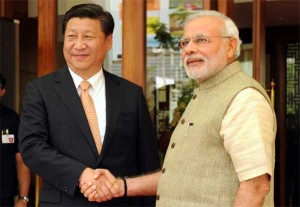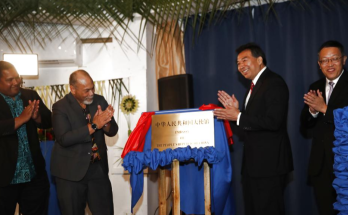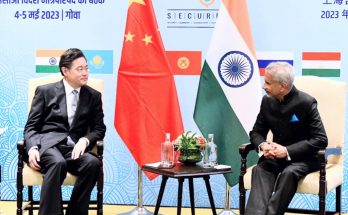 When Prime Minister Narendra Modi met President Xi Ginping in Beijing on Thursday, this was his third meeting with President Xi Jinping in a year. This is an achievement by itself, given the history of China-India relations. But it is also a sign of the times and of the speed and manner in which international relations are transforming. Ahead of the visit, there is considerable optimistic speculation that something dramatic will be announced.
When Prime Minister Narendra Modi met President Xi Ginping in Beijing on Thursday, this was his third meeting with President Xi Jinping in a year. This is an achievement by itself, given the history of China-India relations. But it is also a sign of the times and of the speed and manner in which international relations are transforming. Ahead of the visit, there is considerable optimistic speculation that something dramatic will be announced.
What we will need to see is whether there is any border incident ahead of, or during, the visit. Doubtless, the boundary question and trade imbalance will be discussed. The Chinese will also raise the Tibet issue and our reply will be closely watched. There could be announcements about some mega joint ventures and Chinese investments in Indian infrastructure projects.
Another immediate Indian security interest is the Indian Ocean Region (IOR). The US and China may battle it out for the control of the Western Pacific. China’s assertiveness in the South China Sea challenges US security interests. But the Indian Ocean is where the next contest of the century could be, with an India landlocked out of West and Central Asia by Pakistan and China.
So was it love or arranged?
For both India and China, the region from Aden to Malacca, as well as the littoral from East Africa and Australia, is economically and geo-strategically vital. The US naval presence in the Indian Ocean will continue, but India will have to raise its profile sharply. The recent talk of building a joint India-US aircraft carrier should not be scoffed at merely because it is an American suggestion. Modi could well include a discussion on the IOR with his hosts in Beijing.
Until recently, China accepted that the US was the principal provider of security in Asia. China’s assertiveness lately in Asia from the Sea of Japan, through the South China Sea up to the Gwadar port, is a maritime manifestation of the Chinese challenge to American supremacy. China has begun to strengthen its presence in the area between Pakistan and the Arab world and Iran. It seeks to provide substantial infrastructure assistance to Pakistan, while improving relations with India.
China considers its relations with the US to be the most important. And yet, it has developed close strategic ties with Russia. Both have consistently supported Iran, carrying similar stance on the US position in Ukraine, and have signed multibillion-dollar energy contracts. The Chinese have good relations with Saudi Arabia, which has some strategic relationship with Israel, presumably against Iran. China’s exports to the region and its direct foreign investment have outstripped US contributions.
Simultaneously, China has heightened its economic profile globally and has committed large sums of money in various global financial systems like the Asian Infrastructure Investment Bank (AIIB), seen as a challenge to the US-led world economic order. More so because the Europeans have agreed to join, despite US advice, and since countries from Greece to Britain are scrambling for Chinese investments and trade.
Apart from the AIIB, China has a lead role in the New Development Bank restricted to Brazil, Russia, India and China, the BRICs nations as of now, while the AIIB has 57 founding members. China also has a leading role in the new Credit Reserve Arrangement, which is meant to perform the same functions as the IMF but is restricted to BRICs members.
The Chiang Mai Initiative is not new, having been established in 2000. As a multilateral forum with a total capital of $240 billion, it serves the ASEAN countries, China, Japan and South Korea. The China-led Silk Road Fund has an endowment of $40 billion.
Contrast this with a paltry US contribution of $1.25 billion to the US-backed Millennium Challenge Corp. Add to this the recent Chinese commitment of $45-billion infrastructure assistance to Pakistan. Clearly, Beijing is willing to assert economically across the globe with the kind of finances promised to strengthen its own interests.
Ultimately, the challenge will be to the US dollar and China has ambitions to make its currency one of the reserve currencies at the IMF. Obviously, this would be viewed with concern in Washington. There are doubts being expressed about the sustainability of the Chinese economic and political models. Despite this, it is inevitable that Chinese ambitions will be accommodated.
It seems that China is positioning itself ahead of Xi’s meeting with US President Barack Obama in September. China is also seriously positioning itself to deal with a new incumbent in the White House in 2016 from what it hopes will be a position of strength and equality.
It is important for India to be in some of the calculations, just as much it is necessary for India not to overstretch by wanting to be seen everywhere.
Perhaps Deng Xiaoping’s advice applies to us too: keep a cool head and maintain a low profile. Never take the lead but aim to do something big.
Courtesy : ORF – Modi must ensure India is in China’s global calculations
Author Profile
- India Writes Network (www.indiawrites.org) is an emerging think tank and a media-publishing company focused on international affairs & the India Story. Centre for Global India Insights is the research arm of India Writes Network. To subscribe to India and the World, write to editor@indiawrites.org. A venture of TGII Media Private Limited, a leading media, publishing and consultancy company, IWN has carved a niche for balanced and exhaustive reporting and analysis of international affairs. Eminent personalities, politicians, diplomats, authors, strategy gurus and news-makers have contributed to India Writes Network, as also “India and the World,” a magazine focused on global affairs.
Latest entries
 DiplomacyApril 23, 2024Resetting West Asia, re-booting the world, but not fast enough: T.S. Tirumurti
DiplomacyApril 23, 2024Resetting West Asia, re-booting the world, but not fast enough: T.S. Tirumurti India and the WorldApril 22, 2024India’s G20 Legacy: Mainstreaming Africa, Global South in global agenda
India and the WorldApril 22, 2024India’s G20 Legacy: Mainstreaming Africa, Global South in global agenda DiplomacyApril 10, 2024Diplomat-author Lakshmi Puri pitches for women power at LSR
DiplomacyApril 10, 2024Diplomat-author Lakshmi Puri pitches for women power at LSR India and the WorldApril 6, 2024UN envoy pitches to take India’s solutions to the world stage
India and the WorldApril 6, 2024UN envoy pitches to take India’s solutions to the world stage







